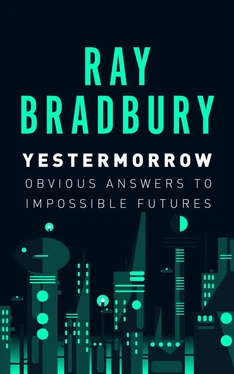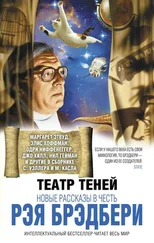Free! Free at last! Free!
What have we been building here? Not just simple hungers and needs. Not just shopping for things. But shopping for sociability, shopping for people.
Consider this: people on a jet have only been on a trip. People on a train have been on a journey.
Jets bore.
Trains enchant.
Because of—texture.
Jets diminish and vanish people.
Trains summon them back in harvests on both sides of the track.
As with jets and trains, so it is with cities and towns.
If you send people only on trips around your town, don’t be surprised if they go off on journeys or hoped-for journeys to other cities as they used to be.
It follows that the more texture, the more surprise you can build into a small town, the better chance you have of keeping them down on the farm after they’ve seen Paree.
We’ve pretty well built our plaza now. How about the Main Street leading to the plaza? Starting one or two blocks away, of course, is where you leave your damn car and hoof it, happily I might add, with or without family, toward the Hearthing Place, the Town Family Park we have been describing. Along the way, the more fast-food places you can add to it the better, so that people can carry their own hot dog or pizza onto a park bench. One of the shops, right at the plaza, might be a picnic-basket lunch emporium where for ten bucks or so you can get a wicker of chicken, corn, french fries, and for a few more bucks a bottle of wine, which you tote over to picnic tables in the plaza which, on its dullest night, is ten steps up from “Starsky and Hutch.” And where, for a dollar, you can step up and sledgehammer a TV set to death in the Play Pit.
What else do we need for people input? The best damn LP record shop in the world, open until two a.m. Popcorn machines everywhere. Candy-making devices in sweet shop windows. Plus the best magazine and newspaper racks this side of Peoria. Stationery shops with so many lovely papers in the window you can’t resist buying what you don’t need.
On the way into all this, some Burma Shave signposts, please:
1984 Will Not Arrive!
But 2001? Man Alive!
Do you see where I travel? Do you know where I want us all to arrive? There isn’t one new idea in all the above. Everything is ancient. But, idiots that we are, we have lost our plazas, destroyed our drug stores, dismantled our fountains, grassed over our sidewalks, and driven our ownselves back into our houses to serve prison sentences meted out by “Baretta,” “Quincy,” or the “Dallas” idiots.
At Disney World, thousands of people just sit and watch, every night. Trouble is, you have to pay to get in, and at midnight or so they shut it up and kick you out.
Look at your average architectural rendering or building layout viewed in magazines during the past 40 years. Where in hell are the people? Those little ants running around on the super-clean sidewalks—are those people? What are they doing? Nothing. Just standing there.
What we do here is put people back into proper scale. Our renderings will show people doing things. Like talking, eating, walking, sitting, playing music, playing games, riding, picking each other up, taking each other home. Their acts, their needs will be visible supports on which to lean a town or draw a facade. They won’t exist for the town, the town will exist for them, which is only proper and right.
It follows that any architect/city planner, future builder, mayor-dreamer, chamber of commerce patriot who welds this People Machine together, will have what happen to him?
One late day in 1988 or so, this builder-planner-dreamer will be seen racing down Main Street pursued by ten thousand wild citizens. Freed from their TV bastille, these maniacs of joy, will catch the builder-dreamer of the People Machine, and will run him for president or (why not?) emperor of the universe!
And when the town center is rebuilt let the refugee airlift begin. From the Piranesi Prison cities mired in 1984, let those who will move back and ahead at the same time. Toward a 1999 that buds and a 2000 that blossoms. Bringing with them, of course, your small or large corporation for employment and sustenance.
A large order. But then the death of towns, the stagnation of cities, and the dooming of millions is no small matter.
But what about those left behind in the big tubercular cities?
The People Machine will fit there, too. Portions of every metropolis are towns to themselves. There’s nothing wrong with Greenwich Village that adding in some of the elements mentioned here wouldn’t cure. In other parts of New York City, clean out a whole city block and load in all of my components. Plaza, bookshop, ice cream parlor, penny arcade, and all.
So, by this century’s end, we can not only revive the small town, but cure the big one, with the same tonics.
And, while we’re at it, try to give back to the cities some of the other elements they have lost, without realizing it, over the years.
We want to stay young forever, isn’t that true?
We want every day to be that day when we were young and we leaped from bed and asked the world what it had to say or show or be that was brand-spanking fresh-born.
We go to world’s fairs for that.
We travel to faraway places for that.
But if all you find when you turn a corner is one more flat surface of marble, one more bank, one more glassless frontage, one more uninhabited edifice, one more unlit shop, the desire to wander, to wonder, extinguishes itself. Torchless candles, we turn and go to other places, other cities that promise delightful twists and turns amongst shops that stay open late or at least stay lit late, so we can eye-browse the trinket windows.
Think how nice it might be if the largest building in any small American town could have one flat surface, windowless, on which one night the Eiffel Tower would, projected, build itself during the evening, with immense flood-tossed images of the Tower one-fourth erected, one-half, three-fourths, and then, at last, erupted tall against the Parisian sky.
At midnight, tear it down.
That is, pull the image from your great laser-beam projector.
Next night, build the Empire State Building there.
Or toss up column upon Bernini column, the facade of the holy Vatican and St. Peter’s.
Or sandwich the White House on top of Monticello on top of Mount Vernon with a lower layer of New Orleans.
This way. Delight.
Wouldn’t you, on occasion, want to go downtown some nights, to see just what in hell had been built or torn down? One more reason to visit the old boring Main Street, on its way back through technological rejuvenation.
All of this applies to both small towns and small parts of large cities. We need at least one building in every town, or in some part of a city, that gives us a sense of identity.
Think how it would be if there were one tower in each town that told us not only what we are—the town—but what we can be—the Universe.
If one of these towers were built in a town, as a prototype, others might follow.
Describe the tower?
Here it is.
It would be a tower with a circular escalator moving very slowly up through time, through images, through sounds, through projections, through three-dimensional objects, bas-reliefs.
And most of its images would be of flight: pterodactyls kiting primeval horizons, birds in migration, or sun symbols forever rising in ancient skies to bring with them the sun kings of time. During the ascension, Marco Polo’s imported Chinese fireworks would light the way, lifting architectural beauties up into the explosive light. Migrations of men would follow, climbing the spiral, multicolored with multitudinous dreams. The dreams being newborn kites and balloons, and gliders and skyscrapers imitating flight in stone. And toward the end of our tower museum ascension, the Wright brothers’ winged bike sifting up from the Kitty Hawk dunes, and all the jets and dirigibles to follow. All of it spiraled to music and the vast firebreath of the Apollo rockets lifting us toward the sun from which we all came. At the top of our climb, the planets, the far suns and our possible future. At the end of our hundred-foot climb, we would step forth in a miniature planetarium to scan a universe that can be ours if we reach out a hand willed by a reaching mind. From there, we would watch future rockets moving off on the last migration toward an inevitable existence through all the eons to come.
Читать дальше











